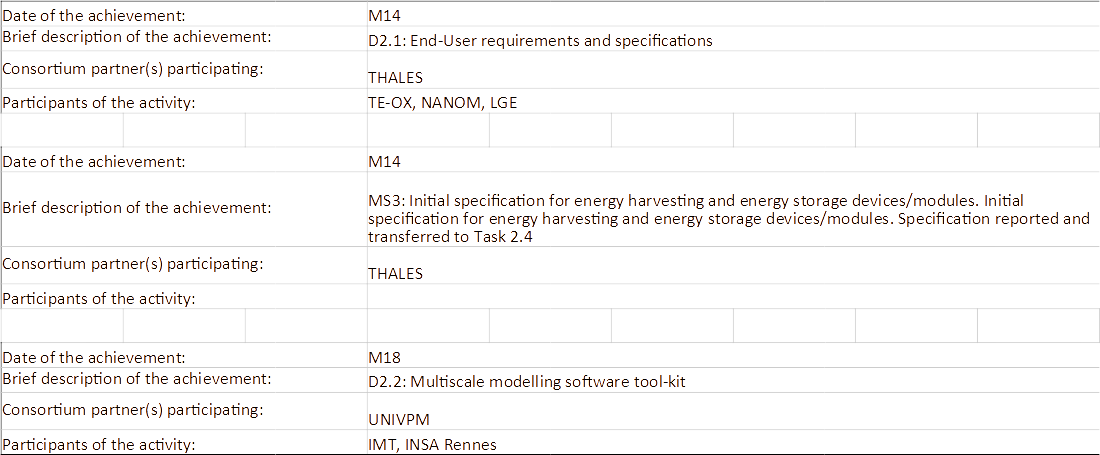The following relevant progress has been achieved:
- The End-User requirements and specification (Deliverable 2.1) and the Multiscale modelling software tool-kit (Deliverable 2.2) have been successfully developed. Moreover, the Milestone centred in the initial specification for energy harvesting and energy storage devices/modules (Milestone 3) has been successfully achieved, with all the initial specifications for energy harvesting and energy storage devices/modules transferred to Task 2.4 [Life Cycle Analysis (LCA) and Life Cycle Cost Analysis (LCC)].
- Simulations (COMSOL Multiphysics) of self-switching diodes (SSDs) based on MoS2 monolayers, using physical and electrical data from the literature and from previous experiments carried out on MoS2, to model in a rigorous way such promising devices for high-frequency CMOS-compatible energy harvesting applications.
- Design and simulation of a bow-tie antenna coupled to a MoS2-based SSD for energy harvesting applications at 24 GHz.
- COMSOL Multiphysics simulations and circuit modelling of pyroelectric harvesters based on HfO2.
- Design and simulation of simple test structures of the planar type (e.g., interdigitated capacitors, transmission lines, resonators) to characterize in a wide frequency range the materials used in NANO-EH.
- Complete design of energy harvesters at 2.45 GHz and 24 GHz, exploiting two solutions integrating silicon substrates.
- Study of a non-linear model for ferroelectric-based devices suitable for future energy harvesters.
- Atomistic simulations of HfO2-based metal-insulator-metal (MIM) diodes. The interfaces and the HfO2 polymorphs can tune and modulate the electron transport properties of the diodes.
- Atomistic to meso-scale modelling of novel nanomaterials: (i) the number of monolayers has an important impact on the performance of MoS2 nanostructures; (ii) the optical and piezoelectric properties increase with the number of explicit monolayers; (iii) monoclinic (P21/c) and orthorhombic (Pca21) polymorphs of HfO2 show important differences between them; (iv) Zr intercalation stabilizes the ferroelectric phase promoting an increase in the optical properties; (v) oxygen vacancies have an evident impact on ferroelectric phase decreasing the performance of the device; (vi) the semiconductor properties of VO2(B) were confirmed by the electronic and optical characteristics of this polymorph.
- Design and simulations of a 60-GHz teardrop antenna on 100-μm-thick high-resistivity silicon (HRSi) substrate.
- Modeling and simulation of pseudo-capacitor electrode using Continuum model.
- Modeling of VO2-based oscillators on LTspice.
- Modeling and simulation of HfZrO-based phase shifters.
- Design of spherical solar cells (conversion efficiency: min 10%, VOC: min 0.7 V; fill factor: min. 0.6) and supercapacitors (capacitance: min. 500 F/g; power density: min. 500 mW/cm3)
- Design of promising MoS2 material for heterojunction solar cells with Si.
- Piezoelectric test devices design: definition of piezoelectric region area and design of contact electrode masks for samples manufacturing; simulation and measurement to evaluate the electrical properties of the manufactured films and validate the use for RF circuits.














